Coriander Rice (Indian Cilantro Rice)
Have you ever found yourself in a culinary rut, desperately seeking a way to jazz up your everyday rice? Well, folks, let me introduce you to the vibrant world of coriander rice! This isn’t just any old side dish. Coriander Rice (Indian Cilantro Rice) is a vibrant, aromatic masterpiece that’ll have you wondering why you ever settled for plain ol’ white rice in the first place.
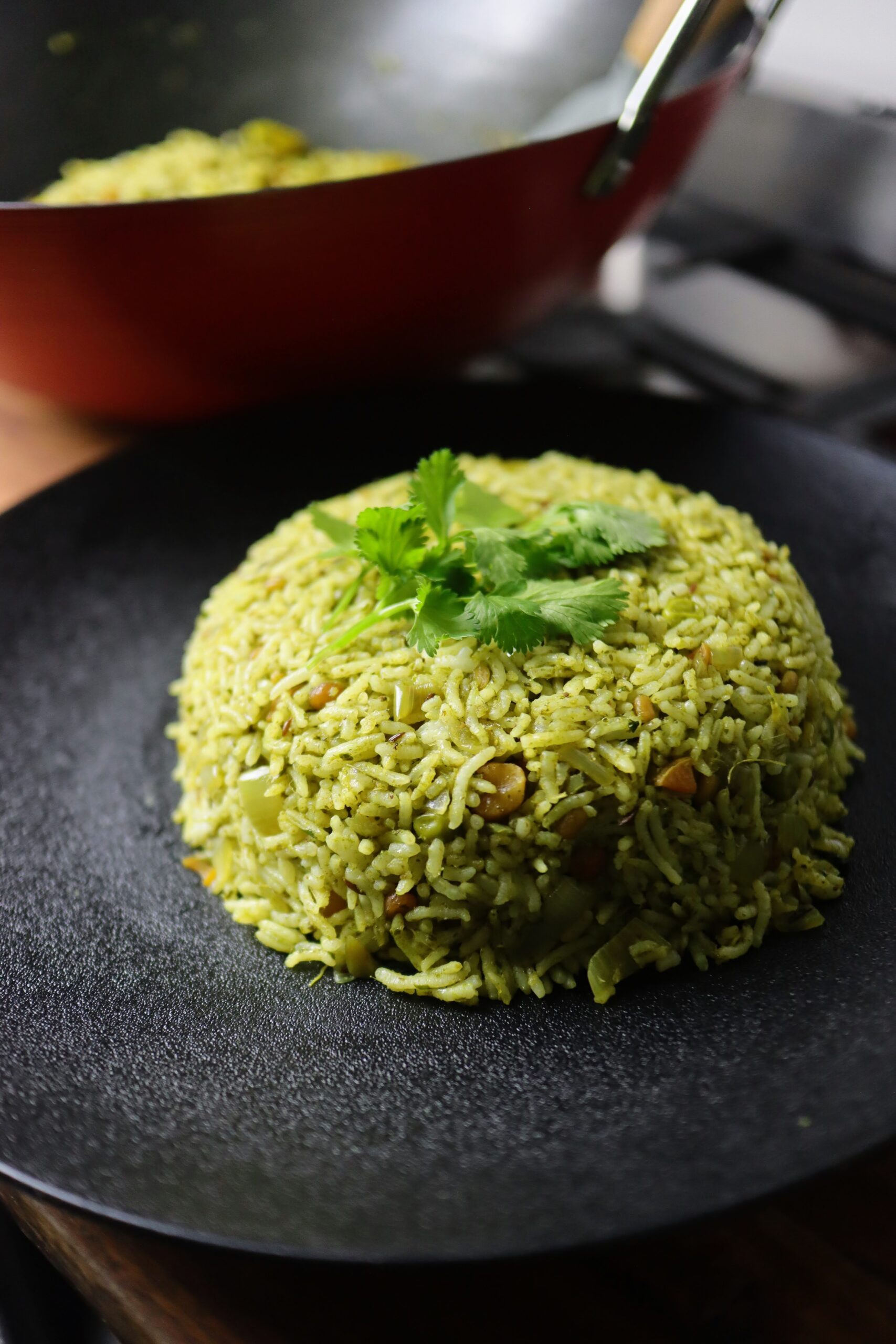
What is Coriander Rice or Cilantro Rice?
Before we get our hands dirty (and deliciously fragrant), let’s talk about what coriander rice actually is. Picture this: fluffy grains of rice, each one lovingly coated with a green, herbaceous embrace. That’s coriander rice in a nutshell – or should I say, in a rice hull? But what is cilantro rice rice made of, you ask? It’s a magical fusion of rice (duh), fresh coriander leaves (also known as cilantro to our friends across the pond), and a medley of spices that’ll make your kitchen smell like a South Indian spice market.
Why You Need This Coriander Rice Recipe in Your Life
Now, you might be thinking, “Why should I bother with a coriander rice recipe when I can just dump some herbs on my regular rice?” Oh, my sweet summer child, let me count the ways:
- It’s a flavour explosion in your mouth. Seriously, it’s like a Bollywood dance number for your taste buds.
- It’s versatile. This coriander rice side dish plays well with others, from spicy curries to grilled meats.
- It’s a nutritional powerhouse. (More on that later, but spoiler alert: coriander rice is healthy!)
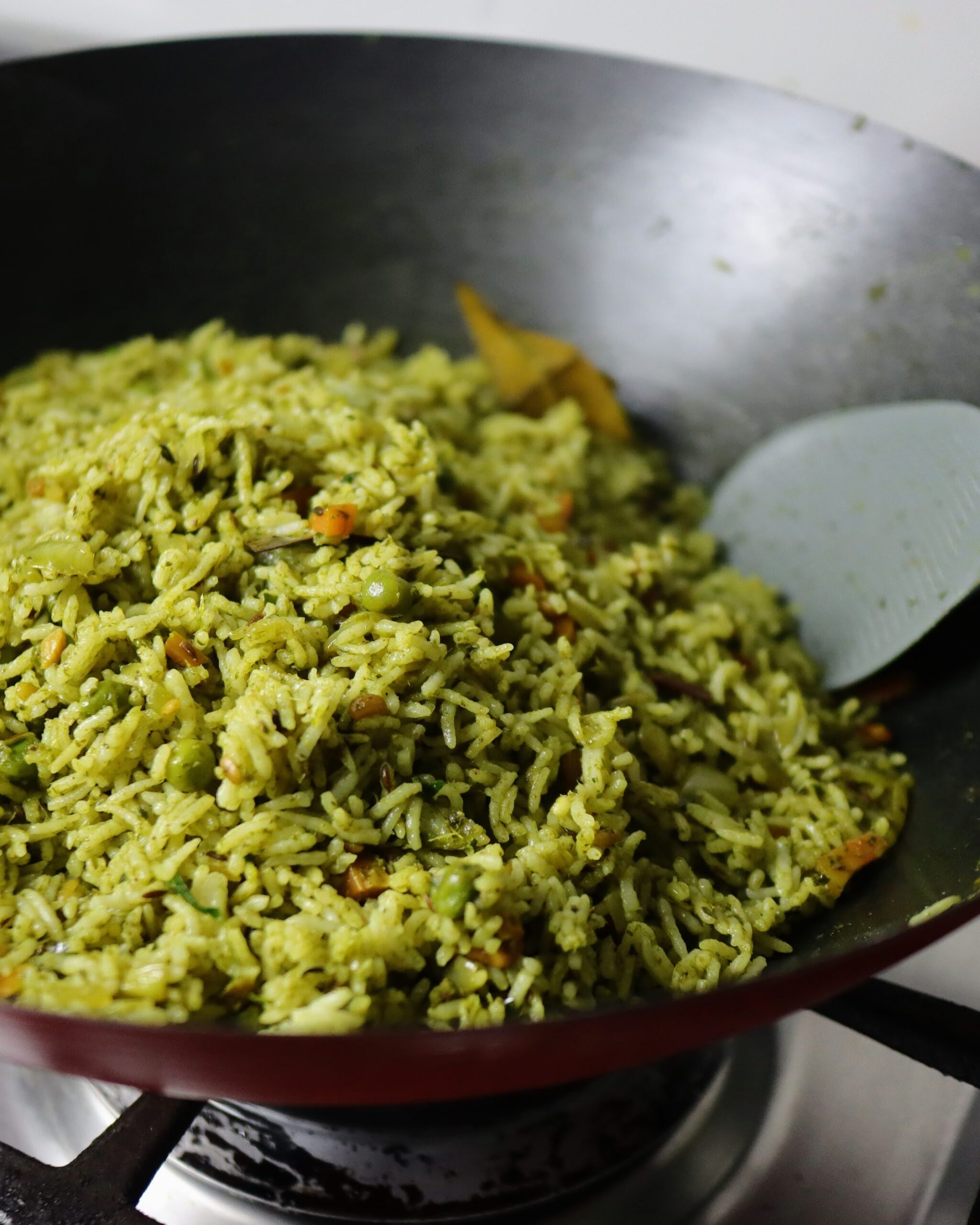
Ingredients for Coriander Rice
Fresh Coriander: The cornerstone of this recipe! Its bright, citrusy flavour transforms ordinary rice into something extraordinary. For the best flavour, use fresh coriander leaves, finely chopped.
Rice Choice: Long-grain basmati rice is the classic choice for its fluffy texture and distinct aroma. However, brown rice or jasmine rice can also be used for a different twist.
Flavour Boosters: A subtle blend of aromatic spices like cumin, cardamom, and bay leaf infuse the rice with depth and complexity. A squeeze of lime juice at the end brightens the flavours and adds a refreshing tang.
Achieving the Perfect Texture in Coriander Rice
The Importance of Rice Selection
The type of rice you choose is paramount in achieving the desired texture.
- Basmati Rice: Known for its long, fluffy grains and distinct aroma, Basmati rice is a popular choice for coriander rice. It cooks quickly and separates well, resulting in a light and airy texture.
- Jasmine Rice: Similar to Basmati, Jasmine rice offers a delicate fragrance and soft, fluffy grains. It’s a good option for a slightly stickier texture if you are into that.
- Long-Grain White Rice: A versatile choice, long-grain white rice cooks to a separate, fluffy texture. It’s a good base for absorbing the flavours of coriander and other seasonings.
The Rinsing Process
Rinsing the rice is a crucial step in achieving the perfect texture.
- Remove Excess Starch: Rinsing thoroughly removes excess starch, preventing the rice from becoming gummy or clumping together.
- How to Rinse: Place the rice in a fine-mesh sieve and run cold water over it until the water runs clear. If you don’t have a sieve, just fill water in a bowl and add rice into it. Rinse it with your hands a few times until the water runs clear
Cooking techniques
The cooking method significantly impacts the rice’s texture.
- Absorption Method: This method involves cooking rice in a specific amount of liquid (usually water or stock) until the liquid is absorbed. A pressure cooker, instant pot or a rice cooker could be used for this type of cooking. It’s ideal for fluffy rice.
- Boiling Method: While less common for coriander rice, boiling also can be used to cook rice. However, it requires careful timing to prevent overcooking and a mushy texture. You also will need to drain excess water from the cooking pot if using this method. In the past, before rice cookers and pressure cookers became mainstream in Indian kitchens, this is how Indian mothers used to prepare rice at home.
Fluffing the Rice
Once cooked, fluffing the rice is essential to prevent clumping and ensure a light, airy texture.
- Use a Fork: Gently fork the rice to separate the grains.
- Spread and Let It Rest: The cooked rice should be transferred to a large platter and gently spread out. Allow the rice to rest for a few minutes before serving.
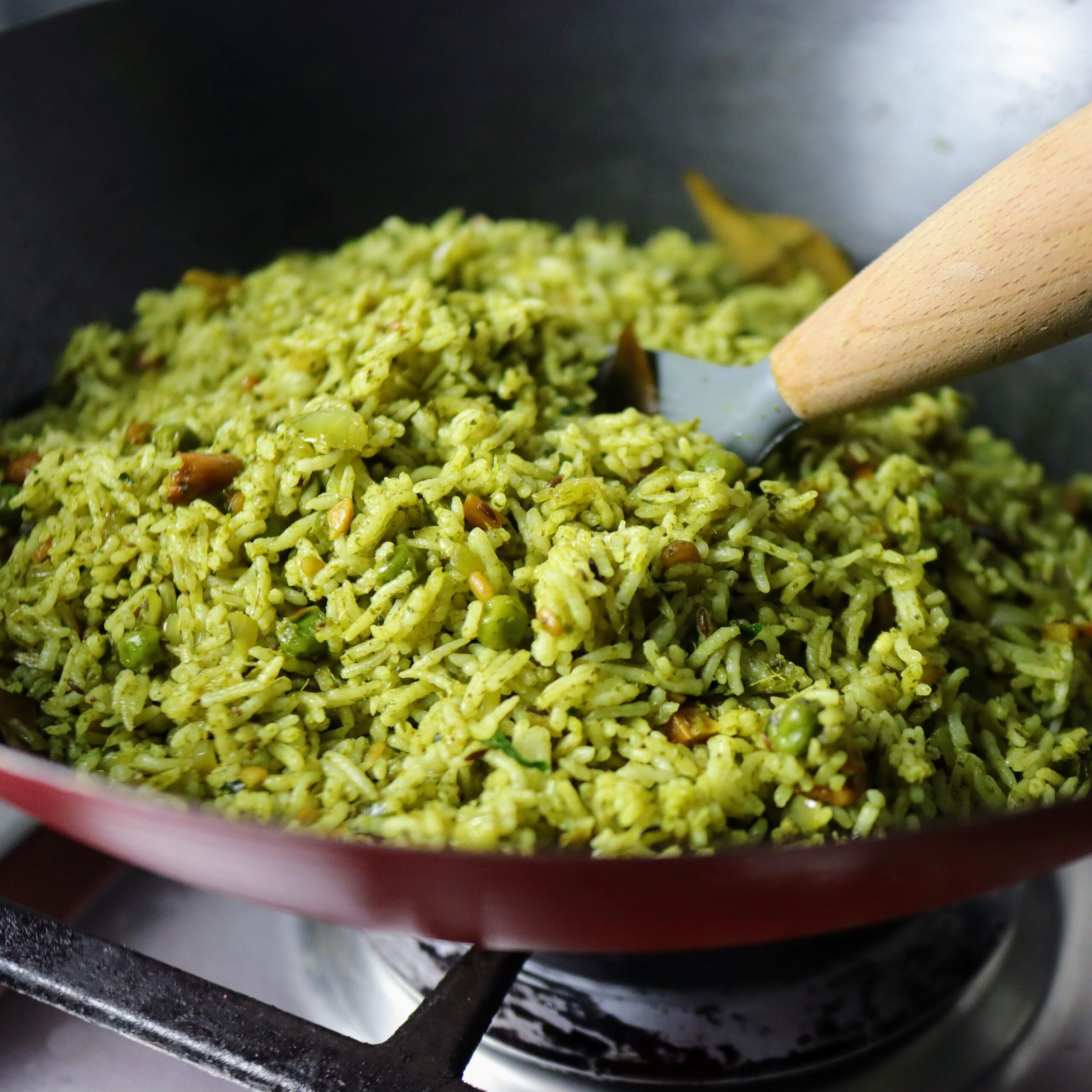
By carefully selecting your rice, rinsing thoroughly, using the appropriate cooking method, and fluffing properly, you can achieve the perfect texture for your coriander rice. Alright, there’s one more thing I did not mention: the trick to consistently achieving fluffy rice. It also has a significant impact on how many calories the body will absorb from consuming rice, which is also one of the main reasons why many individuals avoid eating rice in the first place. I will reveal all about it in the later sections, so please read on.
The Best Coriander Rice Recipe: Step by Step
Alright, let’s get down to brass tacks. Here’s how to make coriander rice that’ll have your dinner guests craving for seconds (and thirds):
Coriander Rice
Course: Main, SidesCuisine: IndianDifficulty: Medium4
servings15
minutes40
minutes55
minutesDiscover a quick and healthy coriander rice recipe bursting with fresh flavours. Perfect for a gluten-free, vegan-friendly meal, this easy dish pairs well with your favorite curries and takes just 20 minutes to make. Learn how to make this aromatic side dish with simple ingredients and elevate your meals effortlessly!
Ingredients
- Cooking Rice
650 gms (~ 2½ cup) uncooked Basmati Rice
2 – 3 tbsp Coconut oil ( use 2 tbsp desi ghee instead if you prefer)
- For Green Masala
130 gm or 2 handfuls Coriander leaves
1 – 1½ inch Cinnamon stick
5 – 7 Cloves
5 – 7 Cardamom pods
marble sized Tamarind
5 Green chillies (adjust to your liking)
1 sprig fresh Curry leaves
5 cloves Garlic
1 inch Ginger piece
- Making Coriander Rice
6 tbsp cooking oil or any other neutral flavoured oil
4 Bay leaves
½ tbsp Cumin seeds
1 tbsp Chana dal
1 tbsp Urad dal
10 broken Cashews
5 slit Green chillies
2 medium sized diced Onions
½ cup Green peas
1 med sized or 1 cup diced Carrots
1 tsp Turmeric powder
1 tsp Cumin powder
Himalayan Pink Salt to taste ( use any salt to your liking)
1 tsp Sugar
650 gm uncooked Basmati Rice
Directions
- Cooking Rice
- First things first, give your rice a good rinse until the water runs clear. This step is crucial, folks! It’s like giving your rice a spa day before the main event.
- Transfer the rinsed rice to the rice cooker and add water. For Basmati Rice, use 2 cups of water to 1 cup rice. Add 2 tbsp ghee (non-vegans) or 2 – 3 tbsp coconut oil to it. Cover the rice cooker lid and turn ON the appliance. Using a rice cooker is one of the easiest ways to cook rice to perfect texture – all you need to do is to get the quantity of water correct and add a dash of ghee or oil to get the perfect fluffy texture.

- Making the Green Coriander paste
- Add all the ingredients – Coriander leaves, Cinnamon, Cloves, Cardamom, Ginger, Garlic, Green chillies, Tamarind and Curry leaves to a mixer grinder and make a coarse paste and set aside.


- Making the Coriander Rice
- Heat the 6 tbsp neutral flavoured cooking oil in a medium to large sized kadai or wok. Keep the flame low if using a thin wok aor over medium for a pan or kadai. Add 4 bay leaves, ½ cumin seeds, 1 tbsp chana dal, 1 tbsp urad dal, 10 cashews and let them dance in the oil for a couple of minutes.
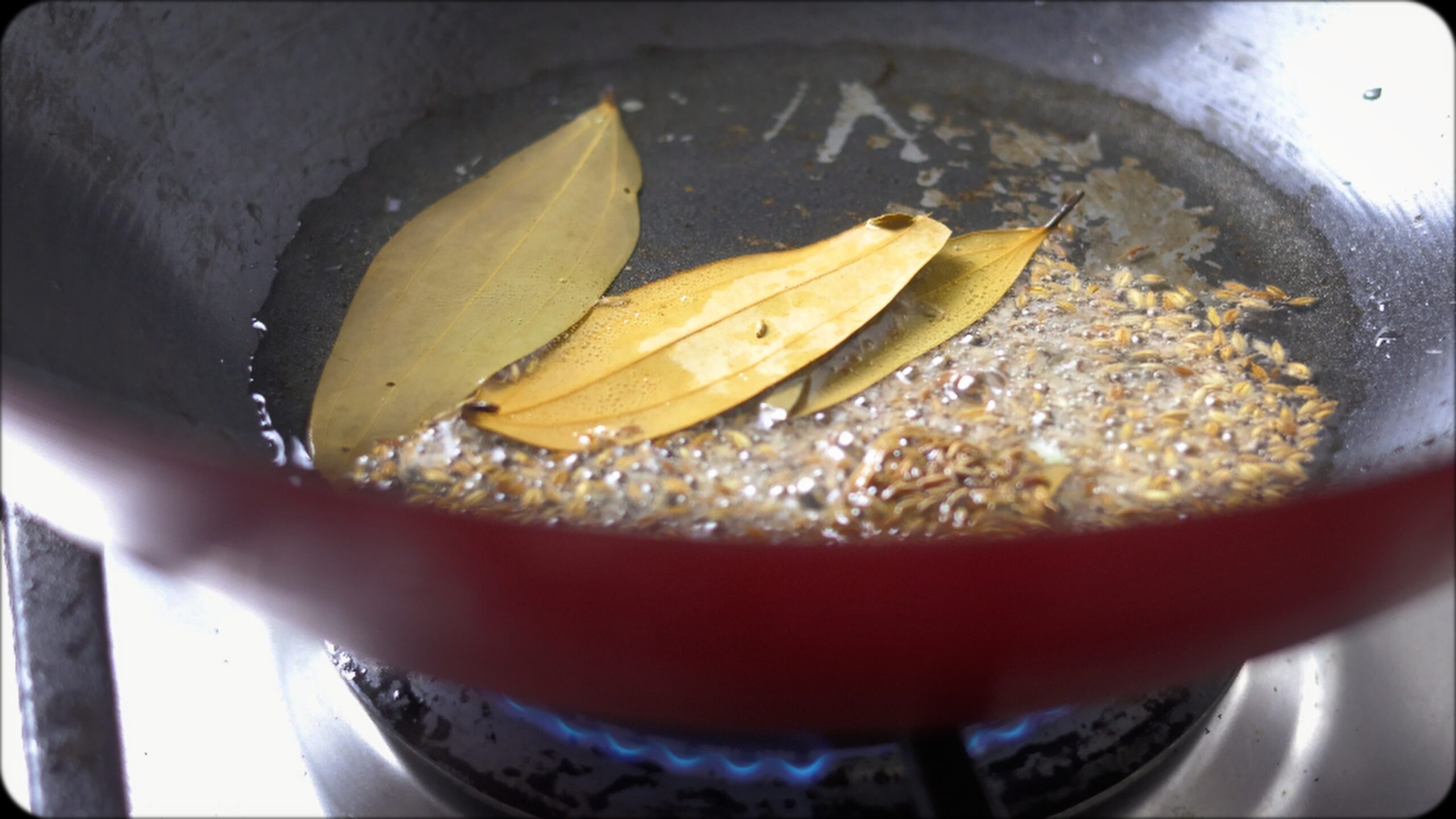

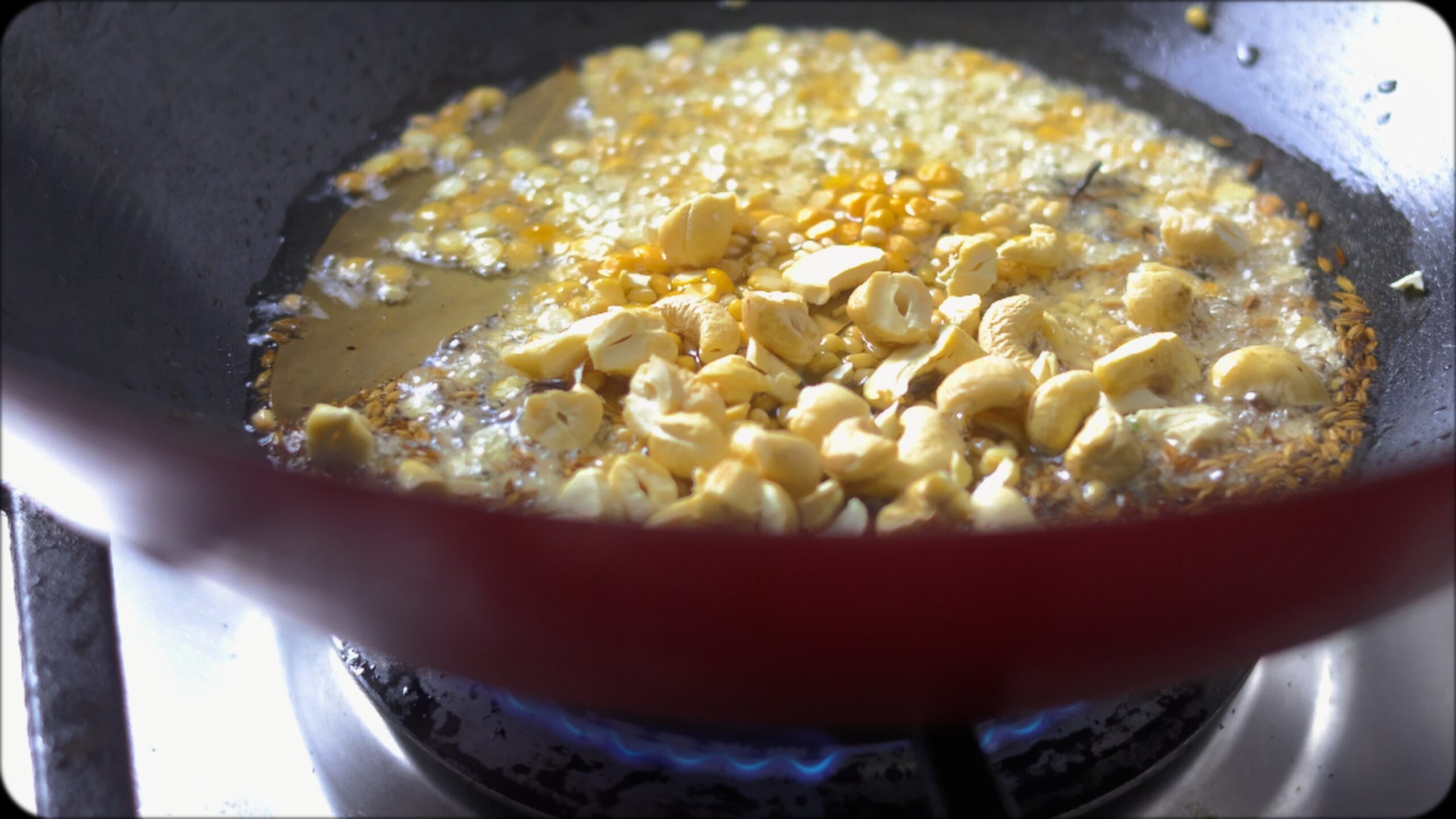
- Add 5 slit green chillies and saute for a few seconds
- Now add 2 medium sized diced onions and saute until they are translucent ~ 2 mins in a wok. Don’t need to brown the onions
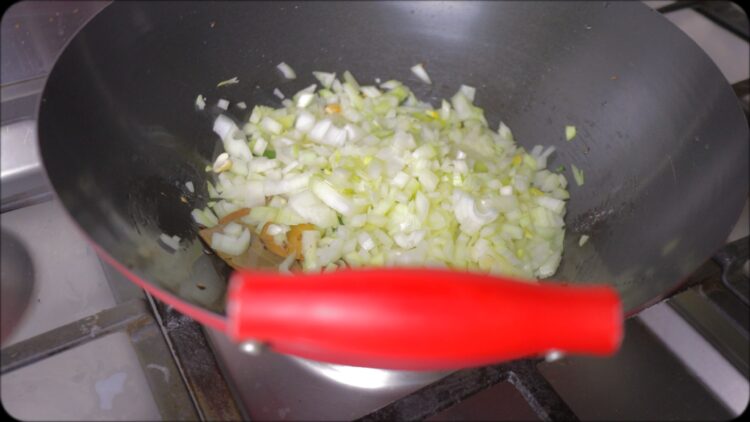
- Add ½ cup green peas and 1 medium sized carrot or a cup dized
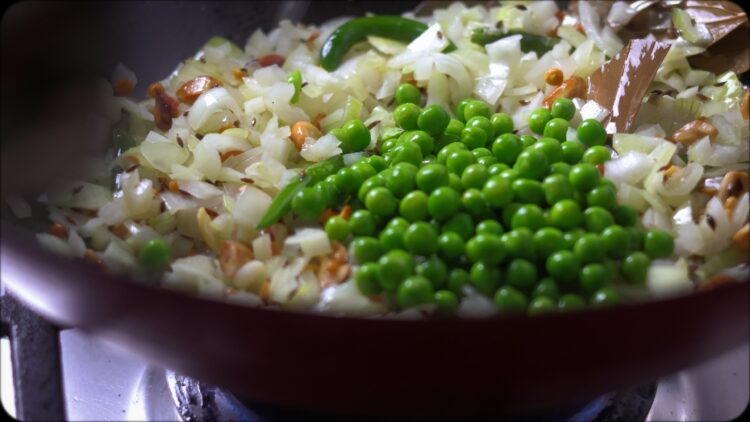
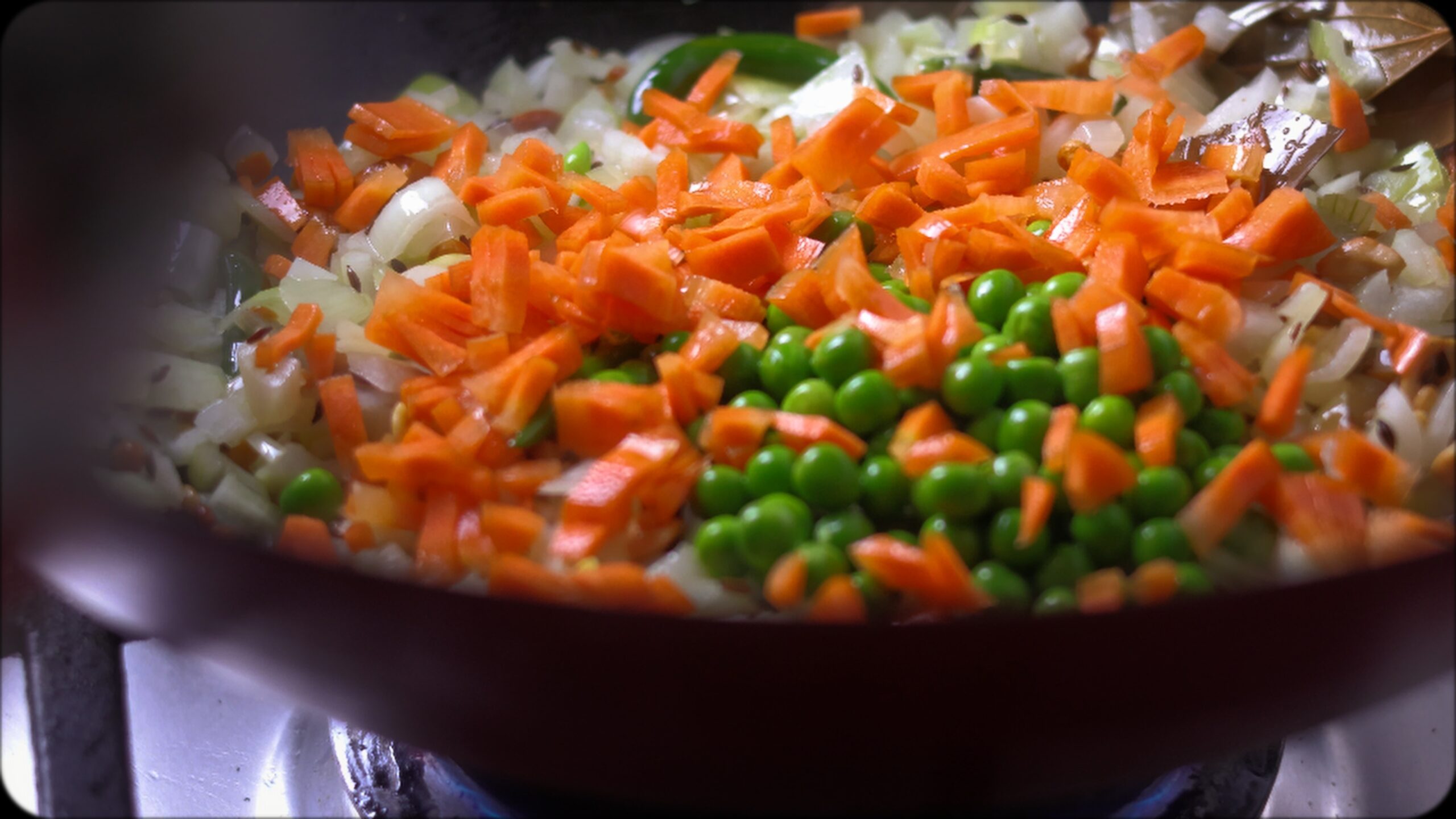
- Saute for almost a minute before adding the powders. 1 tsp Turmeric powder, 1 tsp Cumin powder, Himalayan Pink salt for taste. You could choose to use any salt – table salt, black salt, kosher salt etc. Cover and cook for 5 mins over low flame.
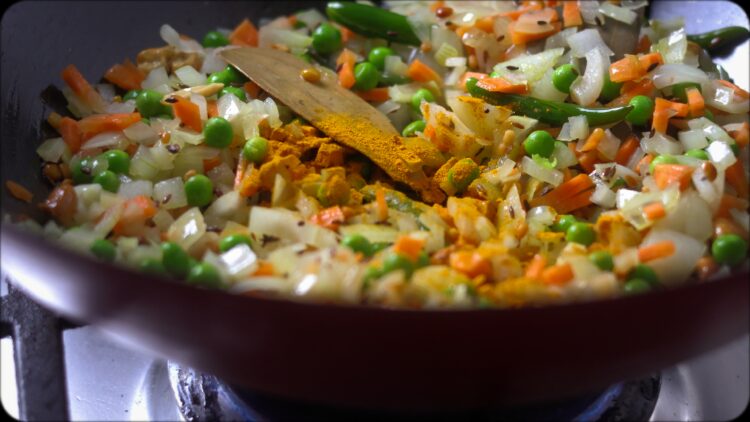
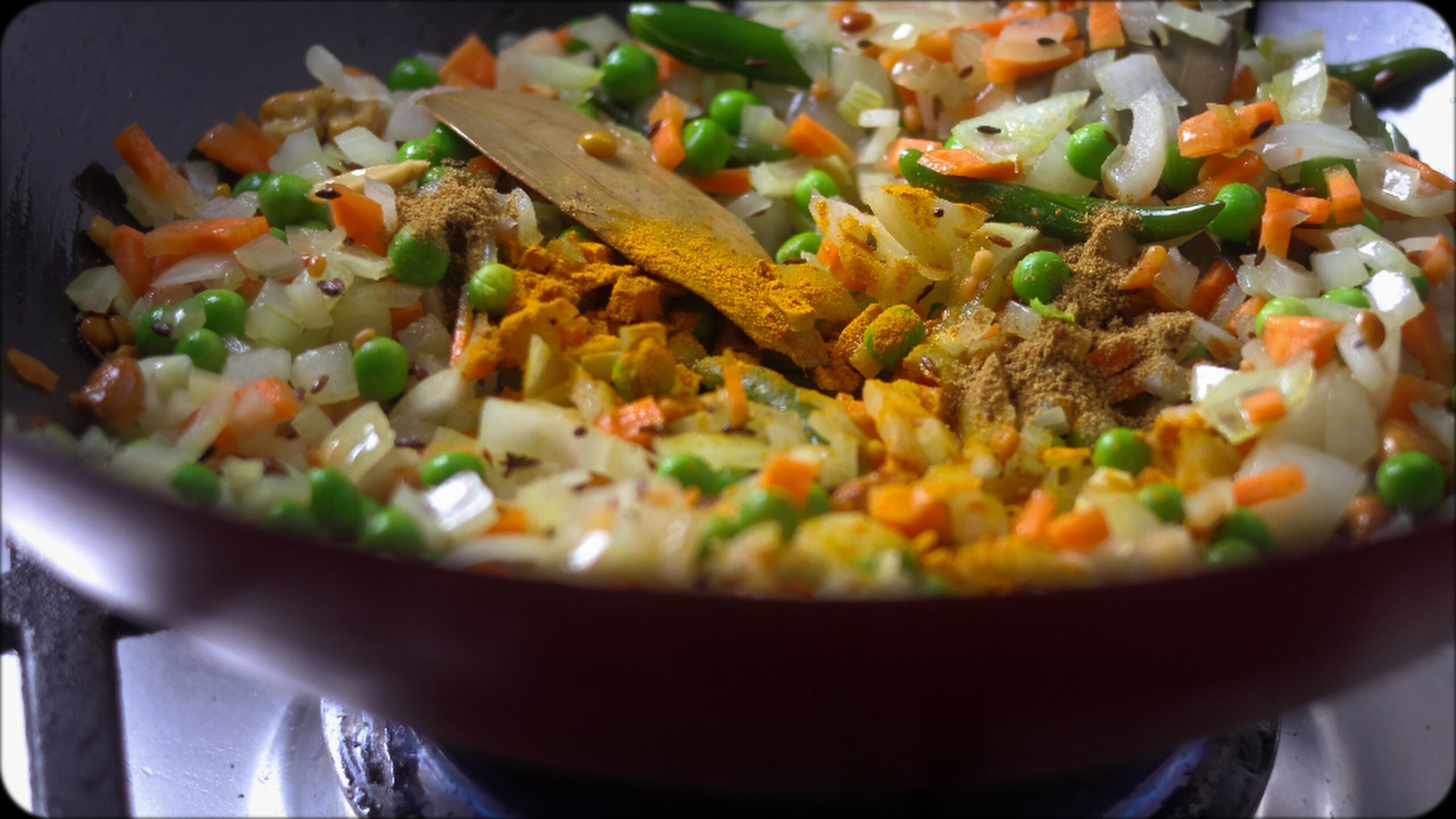

- Now add a tsp of Sugar followed by the green Coriander masala paste and mix well
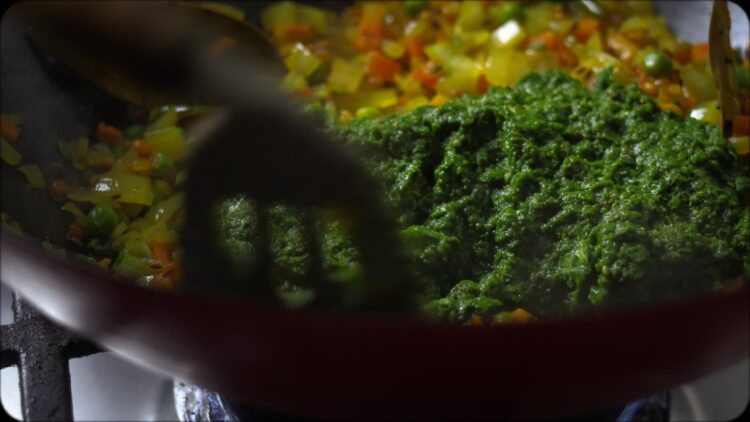
- Cover and cook for another 5 mins over low flame. Stir in between. Cover and cook again.
- Now, add the pre-cooked rice and stir gently to coat each grain with the aromatic mixture. It’s like giving each rice grain a flavourful hug!
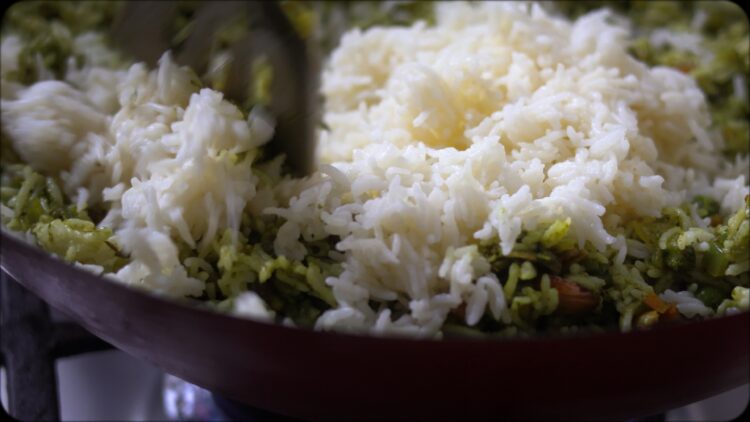
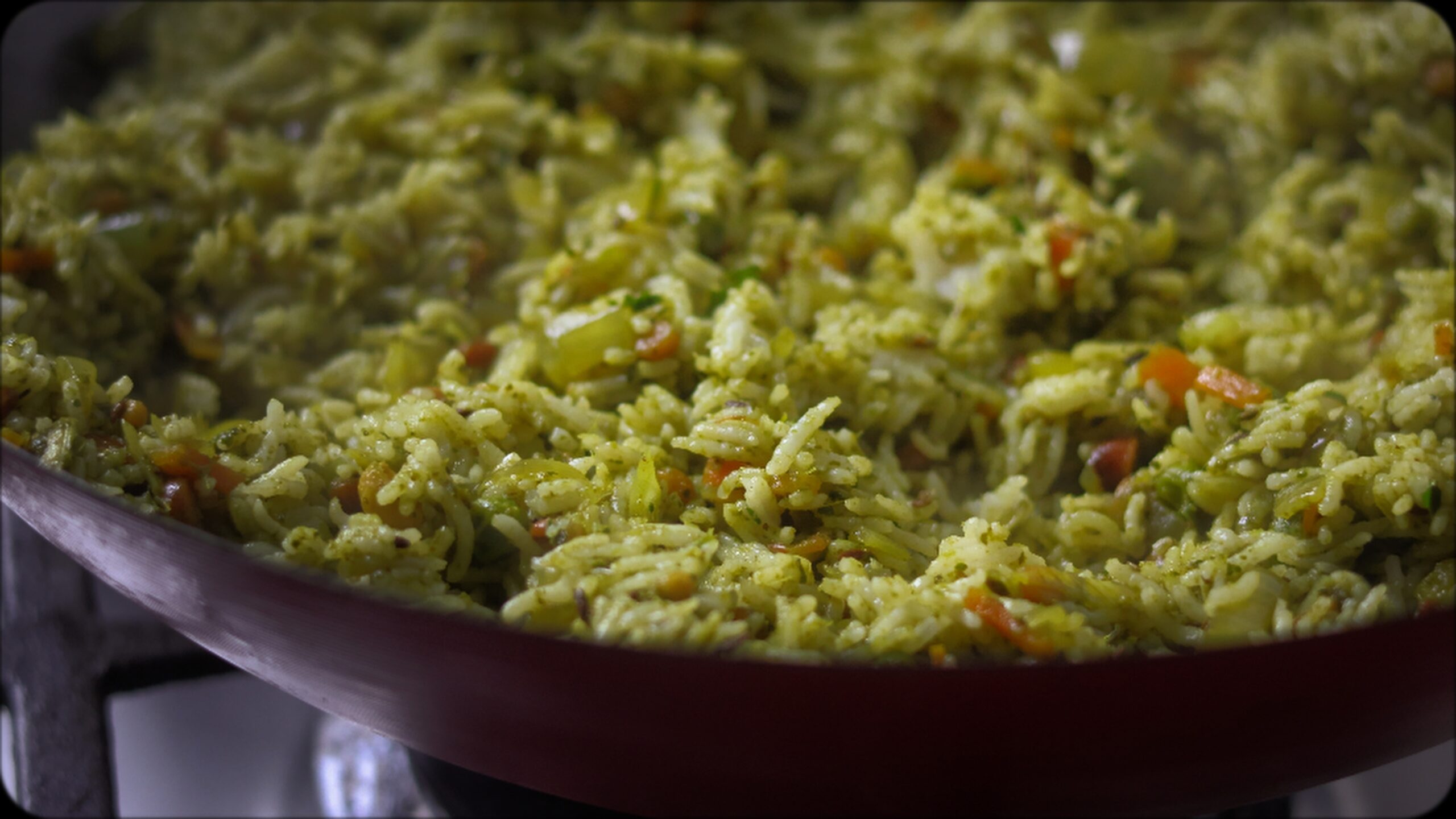
- Turn off the stove
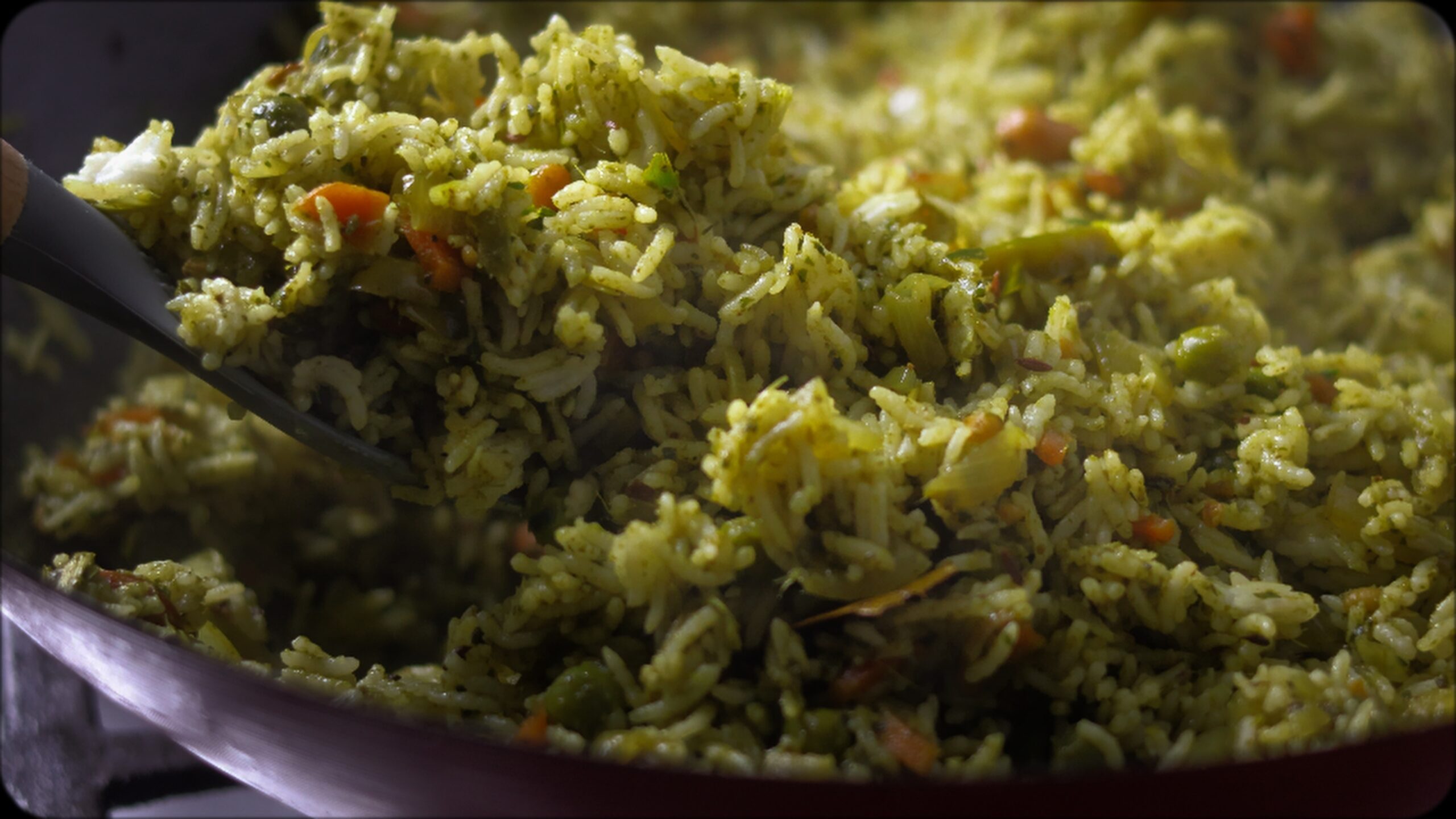
Recipe Video
Notes
- Add cooked rice in batches to ensure that each grain get a coat of the aromatic mixture
- Cooking the rice with coconut oil helps developing resistant starch, which will cut the body’s absorption of calories by half. Moreover, coconut oil adds a pleasant smell and flavour too which I absolutely love.
- You can also make Coriander rice as a one-pot meal where the rice is cooked along with the rest of the coriander paste and spices. Our recipe is all about pre-cooking the rice before mixing with the aromatic spices to get that magical fluffy texture.
- Never stir the rice too vigorously. You just want to move it around until heated through.
How do you Cook Fluffy Rice Consistently?
I am going to reveal the secret right in front of you.
Before cooking the rice, you must add coconut oil to it. Before turning on the rice cooker, you can add it to it. Once cooked, the oil will cover each grain of rice making it fluffy and airy. You can also use desi ghee or clarified butter instead.
Adjust the coconut oil or ghee to the amount of rice used. For 650 grams of uncooked rice (2.5 cups), we used 2 – 3 tbsp of Coconut oil for this recipe. if you are using ghee, 2 tbsp ghee is enough for 650 gms of uncooked rice.
Scientific studies have shown that building resistant starch with this coconut oil approach will reduce the body’s absorption of calories by over half.
Eating cooked rice that has been refrigerated accomplishes the same result.
But Wait, There’s More! Variations of Coriander Rice
Now, I know what you’re thinking. “This coriander rice recipe sounds great, but what if I want to mix it up?”
I’ve got you covered. Here are some variations of coriander rice that’ll keep your taste buds guessing:
- Coriander Rice with Brown Rice: Swap out the basmati for brown rice. It’s like giving your coriander rice a wholesome makeover.
- Spicy Coriander Rice: Amp up the heat with extra green chilies or a dash of red chili powder. It’s not for the faint of heart, though.
- Lemon Coriander Rice: Double up on the lemon juice for an extra zingy kick. It’s like a citrus explosion in every bite!
Health Benefits of Cilantro Rice
Now, let’s talk about why this coriander rice recipe isn’t just a treat for your taste buds, but also a boon for your bod. Is coriander rice healthy, you ask? You bet your bottom dollar it is!
- Weight Loss Wonder: Coriander rice and weight loss go hand in hand. The herb is known to boost metabolism and aid digestion.
- Diabetes-Friendly Delight: Good news for our friends managing blood sugar – coriander rice for diabetes is a smart choice. The herb may help regulate glucose levels.
- PCOS Palliative: Ladies, listen up! Coriander rice benefits for PCOS are worth noting. Its anti-inflammatory properties could help manage symptoms.
- Gluten-Free Goodness: For our gluten-sensitive friends, rejoice! Coriander rice is gluten-free, so you can indulge without worry.
- Calorie Conscious: Worried about coriander rice calories? Don’t be! This dish is relatively low in calories, especially if you opt for brown rice or do the coconut oil technique while cooking.
Storing the leftover Coriander Rice
So, you’ve made enough coriander rice to feed a small army (no judgment here). Now what?
- Cool it down: Let your rice cool to room temperature. It’s like letting a hyperactive child calm down before bedtime.
- Containerize it: Pop it in an airtight container.
- Refrigerate: It’ll keep in the fridge for 3 days. Any longer and it might start planning a rice rebellion if you accidentally end up eating it 🙂
- Reheat with care: Sprinkle a bit of water before reheating to bring it back to its fluffy glory.
What to Serve with Coriander Rice
Now that you’ve mastered this easy coriander rice recipe, let’s talk about what to serve it with.
- Grilled Greatness: Pair it with grilled chicken or veggies for a lighter meal.
- Chips: Potato chips, Pappadams, fryum all pairs well with it.
- Raitas: A cool cucumber raita balances out the flavours perfectly. Have you tried this with Coconut Raita? If you haven’t, you should. I will post a recipe of it soon here, so stay tuned for that.
Coriander Conundrums: Your Burning Questions Answered
Before we wrap this up, let’s address some common questions faster than you can say “pass the coriander rice, please!”
- How much coriander for coriander rice? A good rule of thumb is about 1 cup of chopped coriander leaves per 2 cups of cooked rice. But hey, if you’re a coriander fanatic, go wild!
- Is coriander rice an Indian recipe? While coriander rice has found its way into many cuisines, the coriander rice Indian recipe is particularly popular and flavourful.
- Can I use dried coriander instead of fresh? No, you can’t, and it’d be like using a postcard of the beach instead of actually going to the beach. Fresh coriander leaves is the way to go and that’s how you make it, folks!
Let’s Conclude
And there you have it, folks – everything you ever wanted to know about coriander rice but were afraid to ask. From the best coriander rice recipe to its health benefits, storage tips, and perfect pairings, we’ve covered it all.
Remember, cooking is an adventure, not a strict set of rules. So don’t be afraid to experiment with this recipe. Add a pinch of this, a dash of that – make it your own! Who knows? You might just create the next viral food trend.
So, what are you waiting for? Get in that kitchen and whip up some coriander rice magic. Your taste buds will thank you, your dinner guests will applaud you, and you’ll wonder how you ever lived without this aromatic wonder in your life.
Now, if you’ll excuse me, all this talk about coriander rice has made me hungry. I’m off to raid my fridge for leftovers. Until next time, happy cooking, and may your rice always be fluffy and your coriander leaves always be fresh! 😉
Discover more from The Kitchen Code
Subscribe to get the latest posts sent to your email.


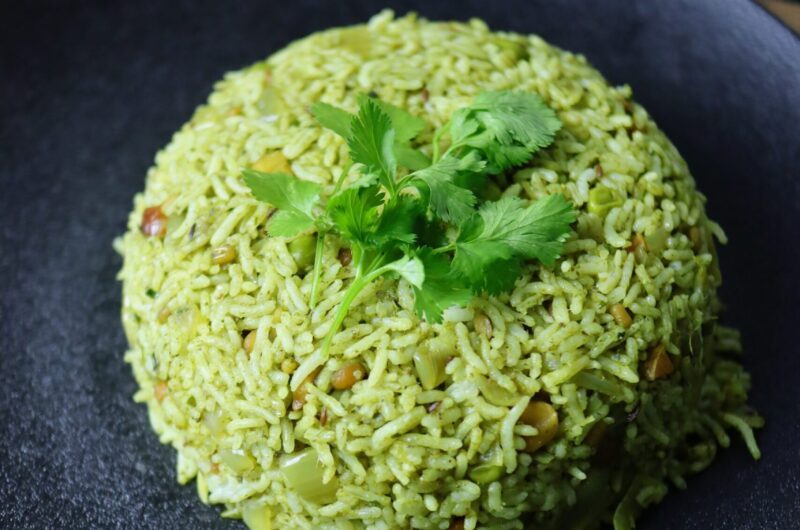
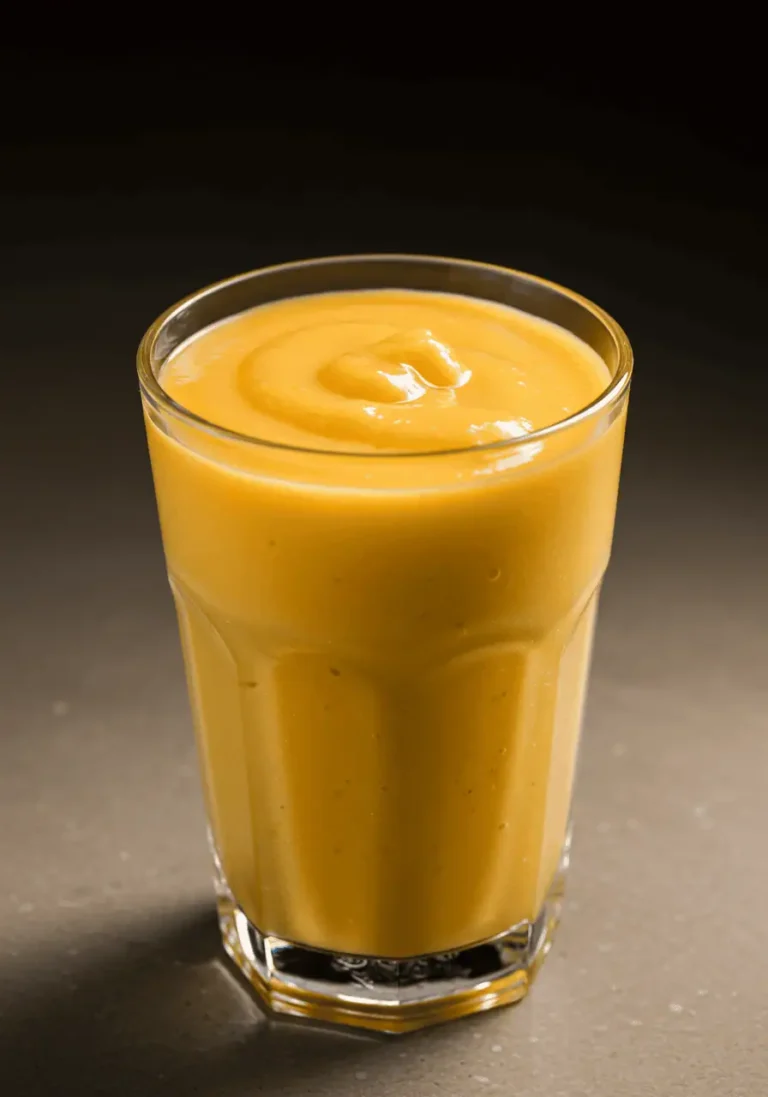
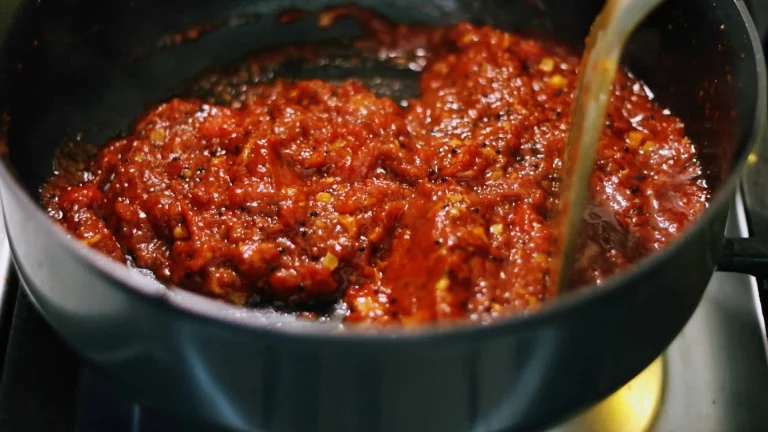
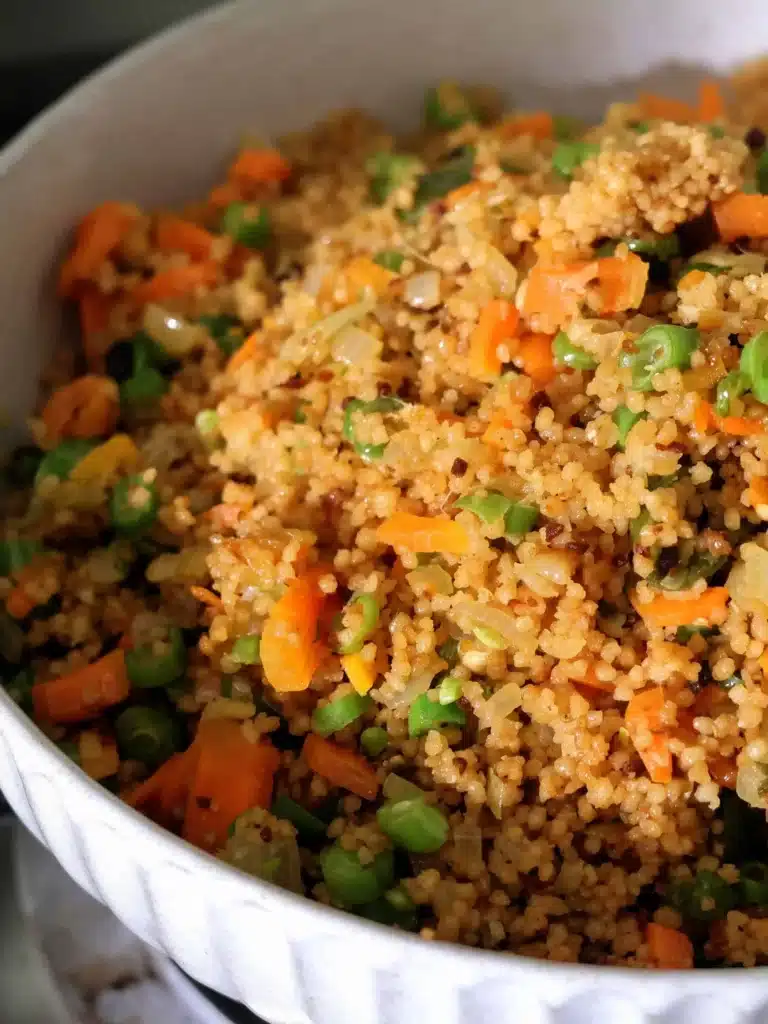
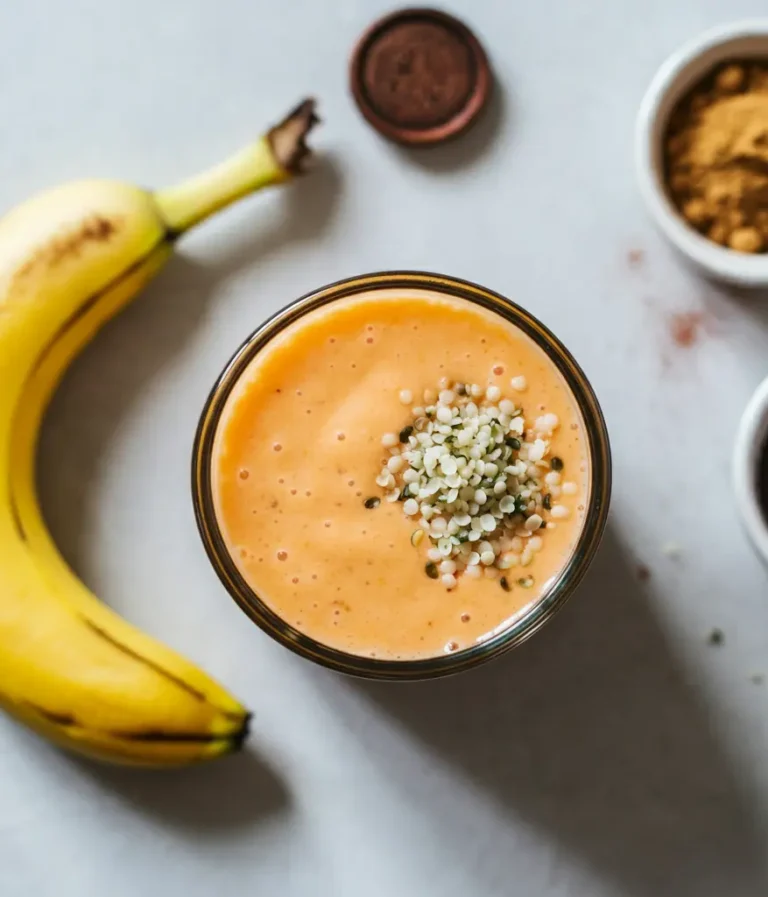
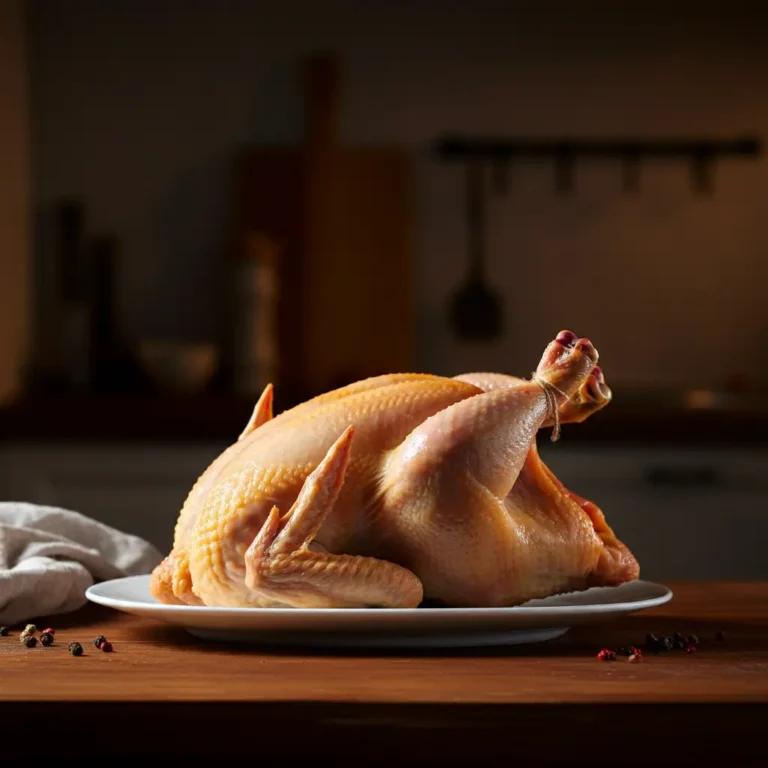
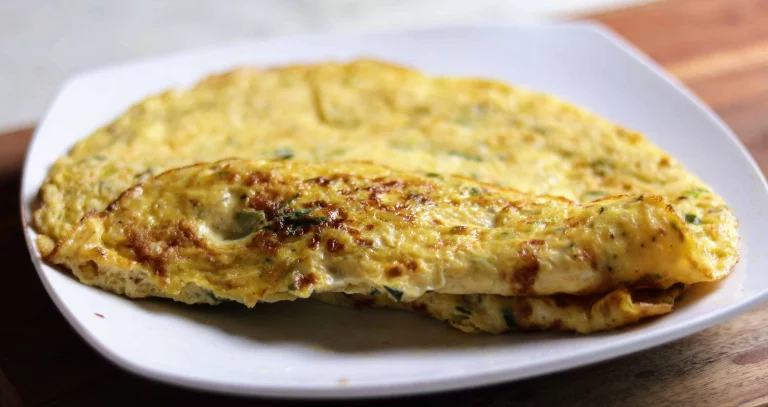
2 Comments